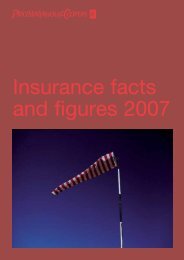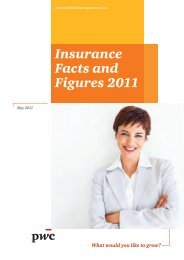Thin capitalisation: eroding asset values and increasing debt ... - PwC
Thin capitalisation: eroding asset values and increasing debt ... - PwC
Thin capitalisation: eroding asset values and increasing debt ... - PwC
Create successful ePaper yourself
Turn your PDF publications into a flip-book with our unique Google optimized e-Paper software.
TaxTalk – Electronic Bulletin of Australian Tax Developments<br />
1. the tax treatment of beneficiaries<br />
should largely replicate the tax<br />
treatment applying if the beneficiary<br />
had derived the trust income directly<br />
2. ‘flow though’ tax treatment<br />
should only apply to trusts<br />
undertaking activity that is primarily<br />
passive investment<br />
3. beneficiaries should be assessable<br />
on their share of the net income of<br />
the trust whether it is paid or applied<br />
for their benefit<br />
4. the trustee should be assessable on<br />
trust income that is not assessable to<br />
beneficiaries in a particular year, <strong>and</strong><br />
5. trust losses should generally be<br />
trapped in the trust subject to<br />
special rules for utilisation.<br />
Having regard to these terms of<br />
reference, the discussion paper<br />
outlines the following three options<br />
for determining tax liabilities of MITs<br />
<strong>and</strong> beneficiaries (as alternatives for<br />
the current reliance on the concept of<br />
present entitlement for allocating liability<br />
between the trust <strong>and</strong> its beneficial<br />
owners) <strong>and</strong> requests ‘stakeholder’<br />
submissions with respect to these<br />
options <strong>and</strong> any other options that<br />
might be appropriate:<br />
• Option 1 – the trustee is assessed<br />
on the net income after allowing a<br />
deduction for certain distributions<br />
made to beneficiaries (the ‘trustee<br />
assessment <strong>and</strong> deduction model’).<br />
Under this option, the liability of<br />
beneficiaries depends on the extent of<br />
distributions made <strong>and</strong>, where the MIT<br />
has accrued income which is included<br />
in assessable income, the MIT may<br />
need to borrow to make distributions<br />
to beneficiaries to avoid tax being<br />
assessed on undistributed income.<br />
• Option 2 – the trustee is exempt from<br />
tax <strong>and</strong> instead, tax on the trust’s<br />
net income is always assessable<br />
to beneficiaries irrespective of<br />
distributions made to them (the<br />
‘trustee exemption model’). The<br />
discussion paper notes that this<br />
provides a high degree of certainty<br />
about where the tax liability will fall,<br />
since there is no requirement for<br />
any distributions to be made for<br />
the beneficiaries to be assessed.<br />
• Option 3 – tax on the trust’s net<br />
income is always assessable to<br />
beneficiaries, provided a substantial<br />
minimum level of annual distributions<br />
(for example 90 per cent) is attained.<br />
The discussion paper notes that this<br />
option reduces the extent to which<br />
beneficiaries are liable to tax on<br />
amounts not received, but there may<br />
be some additional compliance costs<br />
for trustees, who must ensure that<br />
the minimum levels of distributions<br />
are attained to ensure that the trustee<br />
is not taxed. If the minimum level of<br />
distributions is not made, the Board<br />
suggests that the trust could fall out<br />
of the MIT regime entirely with the<br />
income being subject to tax under the<br />
existing trust provisions (Division 6 of<br />
the Income Tax Assessment act 1936).<br />
Alternatively, the Commissioner could<br />
be given discretion to permit the trust<br />
to continue to be taxed as an MIT,<br />
or the trustee could be assessed on<br />
the undistributed amount possibly at<br />
penal rates.<br />
The further option raised by the Board is<br />
to retain the existing Division 6 structure<br />
<strong>and</strong> simply redefine key terms such<br />
as ‘present entitlement’, ‘income of<br />
the trust’ <strong>and</strong> ‘share’ of that income.<br />
This approach would no doubt remove<br />
existing uncertainty with respect to<br />
matters such as the treatment of capital<br />
gains, <strong>and</strong> the debate as to whether the<br />
‘proportionate approach’ or the ‘quantum<br />
approach’ for allocation of net income<br />
is used.<br />
Defining the<br />
term ‘distribution’<br />
The Board notes that under Option 1<br />
(<strong>and</strong> potentially Option 3), it would be<br />
essential for the term ‘distribution’ to be<br />
defined, <strong>and</strong> in that context, the Board<br />
is seeking stakeholder comment on a<br />
definition that would provide clarity <strong>and</strong><br />
ensure appropriate tax outcomes.<br />
Tax rate for undistributed/<br />
unallocated income<br />
The Board raises the issue as to what<br />
tax rate should apply to undistributed<br />
income under Option 1 <strong>and</strong> is seeking<br />
stakeholder input. After noting that the<br />
existing tax rate of 46.5 per cent was<br />
originally designed to remove the cost<br />
to the revenue of trusts accumulating<br />
income, the Board states in the context<br />
of MITs, that the tax rate to apply should<br />
reflect an appropriate balance between<br />
equity <strong>and</strong> integrity.<br />
When is tax<br />
liability determined?<br />
The Board notes that under current law,<br />
a beneficiary’s tax liability arises in the<br />
same year that the income is derived<br />
by the trust, even though an amount<br />
of income may not be distributed to<br />
the beneficiary until the following year.<br />
This position would apply under Option<br />
2, however under Option 1, the paper<br />
outlines the following two approaches<br />
that could be adopted:<br />
• The trustee could be given say three<br />
months after the end of the income<br />
year to make distributions for that<br />
year. The paper notes that a period<br />
of three months aligns with the period<br />
allowed for withholding by MITs from<br />
distributions to foreign residents.<br />
PricewaterhouseCoopers :
















